clutch OPEL GT-R 1973 Owners Manual
[x] Cancel search | Manufacturer: OPEL, Model Year: 1973, Model line: GT-R, Model: OPEL GT-R 1973Pages: 625, PDF Size: 17.22 MB
Page 501 of 625

I4I
.7C.140 .1973 OPEL SERVICE MANUAL
J-7004-1SLIDE HAMMER
J-2291 3MAIN SHAFT ASSEMBLY TOOL
J-22929SPEEDOMETER DRIVEN GEAR
REMOVER AND INSTALLER
J-22922J-22926TRANSMISSION CASE EXTENSIONSPEEDOMETER DRIVEN
HOUSING SEAL INSTALLERGEAR PIN REMOVER
J-21715DETENT PIN PLUG REMOVER
J-22934CLUTCH PLATE ALIGNING ARBORTRWARC PLIERS
J-22923REVERSE IDLER SHAFT REMOVER
J-2291 I
J-21 684NEEDLE BEARING LOADER
BEARING PRESS PLATE7&56
Figure
7C-235 Special Tools. Manual Transmission
Page 526 of 625

REFRIGERANT COMPONENTS
ALL MODELS
CONTENTS
Subject
DESCRIPTION AND OPERATION:
FundamentalPrinciplesofRefrigeration..................
Description of Air Conditioning Components
..........DIAGNOSIS:
GeneralInformation..........................................................
Leak Testing
System1........................................................
Functional Testing System............................................
DiagnosisGuide..................................................................
MAINTENANCE AND ADJUSTMENTS:
General Service Information and
Safety Precautions;........................................................
Charging
andDischargingSystem..............................
AddingOiltotheSystem................................................
Flushing the System........................................................
MAJOR REPAIR:
Removal and Installation Compressor
Opel1900.Manta........................................................
GT
........................................................................................
Removal and Installation Condenser
Receiver-Dehydrator
Assembly
- GT.................................................................
Receiver-Dehydrator
.Opel 1900.Manta................GT..................................................
Removal and Installation Evaporator and
Expansion Valve
- Opel 1900.Manta....................
GT......................................................
Disassembly and Reassembly of Clutch Drive
Plate
andShaftSeal....................................................
Disassembly and Reassembly of Pulley Assembly
and Coil and Housing Assembly..............................
Disassembly and
Reaissembly of Internal
Parts of Compressor and Leak Testing
Compressor..............................................................................
SPECIFICATIONS:
Specifications........................................................................Page No.
9B-18
98-33
98-38
98-39
98-39
90-40
98-41
98-41
9B-47
98-48
98-48
98-56
98-62
90-4990-58
98-52
98-59
98-63
98-67
98-69
98-82REFRIGERANT COMPONENTS ALL MODELS
96-17
Page 535 of 625
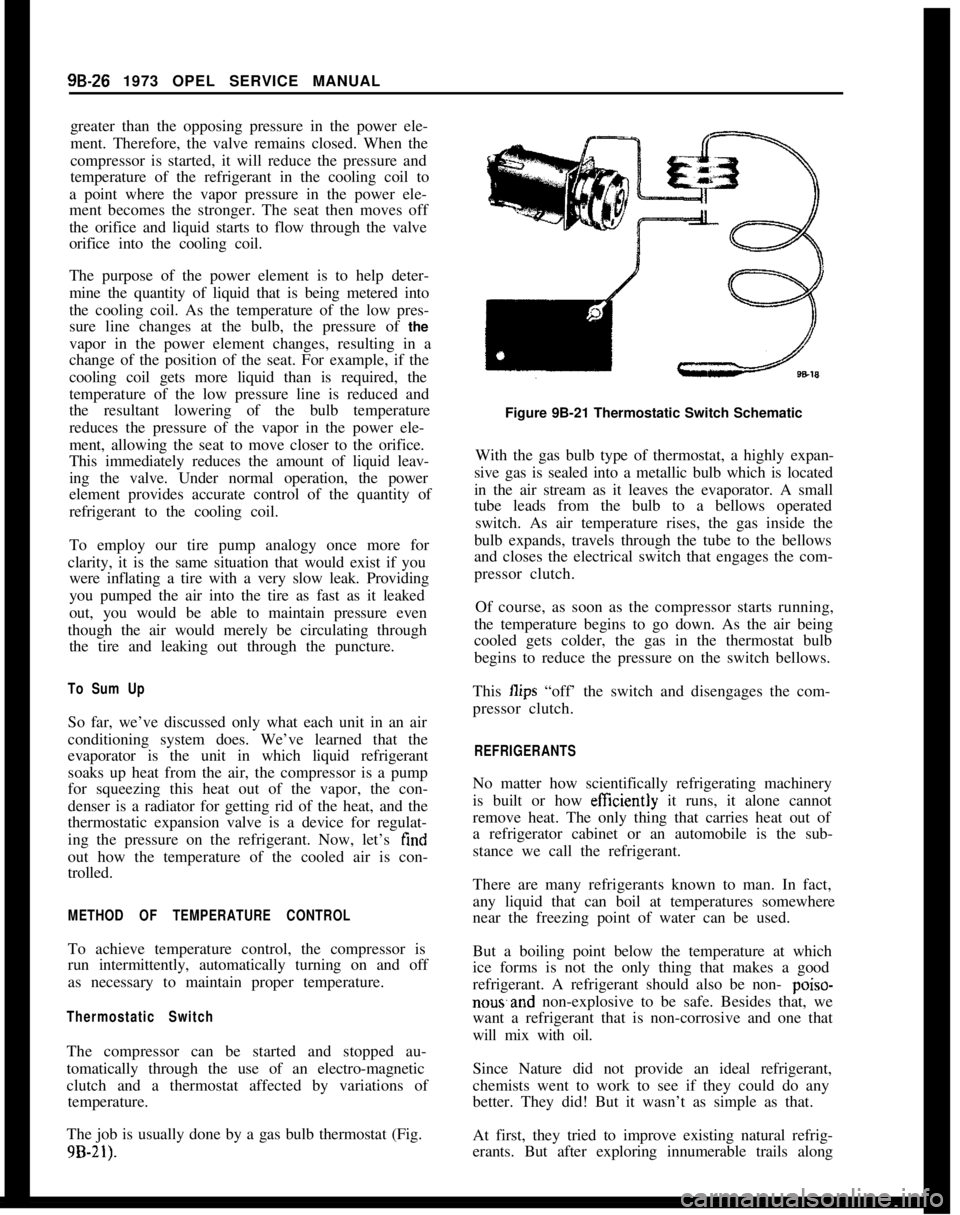
98-26 1973 OPEL SERVICE MANUAL
greater than the opposing pressure in the power ele-
ment. Therefore, the valve remains closed. When the
compressor is started, it will reduce the pressure and
temperature of the refrigerant in the cooling coil to
a point where the vapor pressure in the power ele-
ment becomes the stronger. The seat then moves off
the orifice and liquid starts to flow through the valve
orifice into the cooling coil.
The purpose of the power element is to help deter-
mine the quantity of liquid that is being metered into
the cooling coil. As the temperature of the low pres-
sure line changes at the bulb, the pressure of
the
vapor in the power element changes, resulting in a
change of the position of the seat. For example, if the
cooling coil gets more liquid than is required, the
temperature of the low pressure line is reduced and
the resultant lowering of the bulb temperature
reduces the pressure of the vapor in the power ele-
ment, allowing the seat to move closer to the orifice.
This immediately reduces the amount of liquid leav-
ing the valve. Under normal operation, the power
element provides accurate control of the quantity of
refrigerant to the cooling coil.
To employ our tire pump analogy once more for
clarity, it is the same situation that would exist if you were inflating a tire with a very slow leak. Providing
you pumped the air into the tire as fast as it leaked
out, you would be able to maintain pressure even
though the air would merely be circulating through the tire and leaking out through the puncture.
To Sum Up
So far, we’ve discussed only what each unit in an air
conditioning system does. We’ve learned that the
evaporator is the unit in which liquid refrigerant
soaks up heat from the air, the compressor is a pump
for squeezing this heat out of the vapor, the con-
denser is a radiator for getting rid of the heat, and the
thermostatic expansion valve is a device for regulat-
ing the pressure on the refrigerant. Now, let’s
find
out how the temperature of the cooled air is con-
trolled.
METHOD OF TEMPERATURE CONTROL
To achieve temperature control, the compressor is
run intermittently, automatically turning on and off
as necessary to maintain proper temperature.
Thermostatic Switch
The compressor can be started and stopped au-
tomatically through the use of an electro-magnetic
clutch and a thermostat affected by variations of temperature.
The job is usually done by a gas bulb thermostat (Fig.
9B-21).
Figure 9B-21 Thermostatic Switch Schematic
With the gas bulb type of thermostat, a highly expan-
sive gas is sealed into a metallic bulb which is located
in the air stream as it leaves the evaporator. A small
tube leads from the bulb to a bellows operated switch. As air temperature rises, the gas inside the
bulb expands, travels through the tube to the bellows
and closes the electrical switch that engages the com-
pressor clutch.
Of course, as soon as the compressor starts running,
the temperature begins to go down. As the air being
cooled gets colder, the gas in the thermostat bulb
begins to reduce the pressure on the switch bellows.
This
Ilips “off’ the switch and disengages the com-
pressor clutch.
REFRIGERANTS
No matter how scientifically refrigerating machinery
is built or how
efftciently it runs, it alone cannot
remove heat. The only thing that carries heat out of
a refrigerator cabinet or an automobile is the sub-
stance we call the refrigerant.
There are many refrigerants known to man. In fact,
any liquid that can boil at temperatures somewhere
near the freezing point of water can be used.
But a boiling point below the temperature at which
ice forms is not the only thing that makes a good
refrigerant. A refrigerant should also be non-
poiso-
nowand non-explosive to be safe. Besides that, we
want a refrigerant that is non-corrosive and one that
will mix with oil.
Since Nature did not provide an ideal refrigerant,
chemists went to work to see if they could do any
better. They did! But it wasn’t as simple as that.
At first, they tried to improve existing natural refrig-
erants. But after exploring innumerable trails along
Page 542 of 625

REFRIGERANT COMPONENTS ALL MODELS99- 33
That the attraction of the drying material for mois-
ture is so powerful that if the receiver is left open,
moisture will be drawn in from the outside air.
That just one drop of water added to the refrigerantwill start chemical changes that can result in corro-
sion and eventual breakdown of the chemicals in the
system. Hydrochloric acid is the result of an R-12
mixture with water.
That the smallest amount of air in the refrigeration
system may start reactions that can cause malfunc-
tions.
That the drying agent in the receiver-dehydrator is
Activated Silica Alumina (silica-gel).
That
the inert gas in the expansion valve capillary
line is carbon dioxide.
DESCRIPTION OF AIR CONDITIONING
COMPONENTS
Compressor
The compressor is located in the engine compart-
ment. The purpose of the unit is to draw the low
pressure,gas from the evaporator and compress this
gas into a high temperature, high pressure gas. This
action will result in the refrigerant having a higher
temperature than the surrounding air.
The
cortipressor is of basic double action piston de-
sign. Three horizontal double acting pistons make up
a six cylinder compressor (See Figure
9B-162). The
pistons operate in
l-1/2 inch bore and have a l-1/8
inch stroke. A
wash plate keyed to the shaft drives
the pistons. The shaft is belt driven through a mag-
netic clutch and pulley arrangement. An oil pump
mounted at the rear of the compressor picks up oil
from the
botto’m of the compressor and lubricates the
bearings’and other internal parts of the compressor.
Reed type valves at each end of the compressor open
or close to control the flow of incoming and outgoing refrigerant. Two gas tight passages interconnect
chambers of the front and rear heads so that there is
one common suction port, and one common dis-
charge port. The internal parts of the compressor
function, as follows:
1. Suction Valve Reed Discs and Discharge Valve
Plates
_ The two suction valve reed discs and two
discharge valve plates (see Figure
9B-25) operate in
a similar but opposite manner. The discs are com-
posed of three reeds and function to open when the
pistons are on the intake portion of their stroke
(downstroke), and close on the compression stroke.
The reeds allow low pressure gas to enter the cylin- ders. The discharge valve plates also have three
reeds, however, they function to open when the pis- tons are on the compression portion of their stroke
(upstroke), and close on the intake stroke. High pres-
sure gas exits from discharge ports in the discharge
valve plate. Three retainers riveted directly above the
reeds on the valve plate serve to limit the opening of
the reeds on the compression stroke.
SUCTION VALVE
DISCHARGE-VALVE PLATES
Figure
98-25 - Compressor Suction Valve Reed Discs
and Discharge Valve Plates
2. Front and Rear Heads - The front and rear heads
(Figure
9B-26) serve to channel the refrigerant into
and out of the cylinders. The front head is divided
into two separate passages and the rear head is di-
vided into three separate passages. The outer passage
on both the front and rear heads channels high pres-
sure gas from the discharge valve reeds. The middle
passage of the rear head also contains the port open-
ing to the superheat switch cavity. This opening in
the rear head permits the superheat switch to be
affected by suction gas pressure and suction gas tem-
perature for the operating protection of the compres-
sor. The inner passage on the rear head houses the
oil pump inner and outer rotors. A Teflon sealing
material is bonded to the sealing surfaces separating
the passages in the rear head.
“0” rings are used to
affect a seal between the mating surfaces of the heads
and the shell. The front head suction and discharge
passages are connected to the suction and discharge
passages of the rear head by a discharge tube and
suction passage in the
body of the cylinder assembly.
A screen located in the suction port of the rear head
prevents foreign material from entering the circuit.
3. Oil Pump
- An internal tooth outer rotor and
external tooth inner rotor comprise the oil pump.
The pump works on the principle of a rotary type pump. Oil is drawn up from oil reservoir in underside
of shell through the oil inlet tube (see Figure
9B-27)
Page 543 of 625
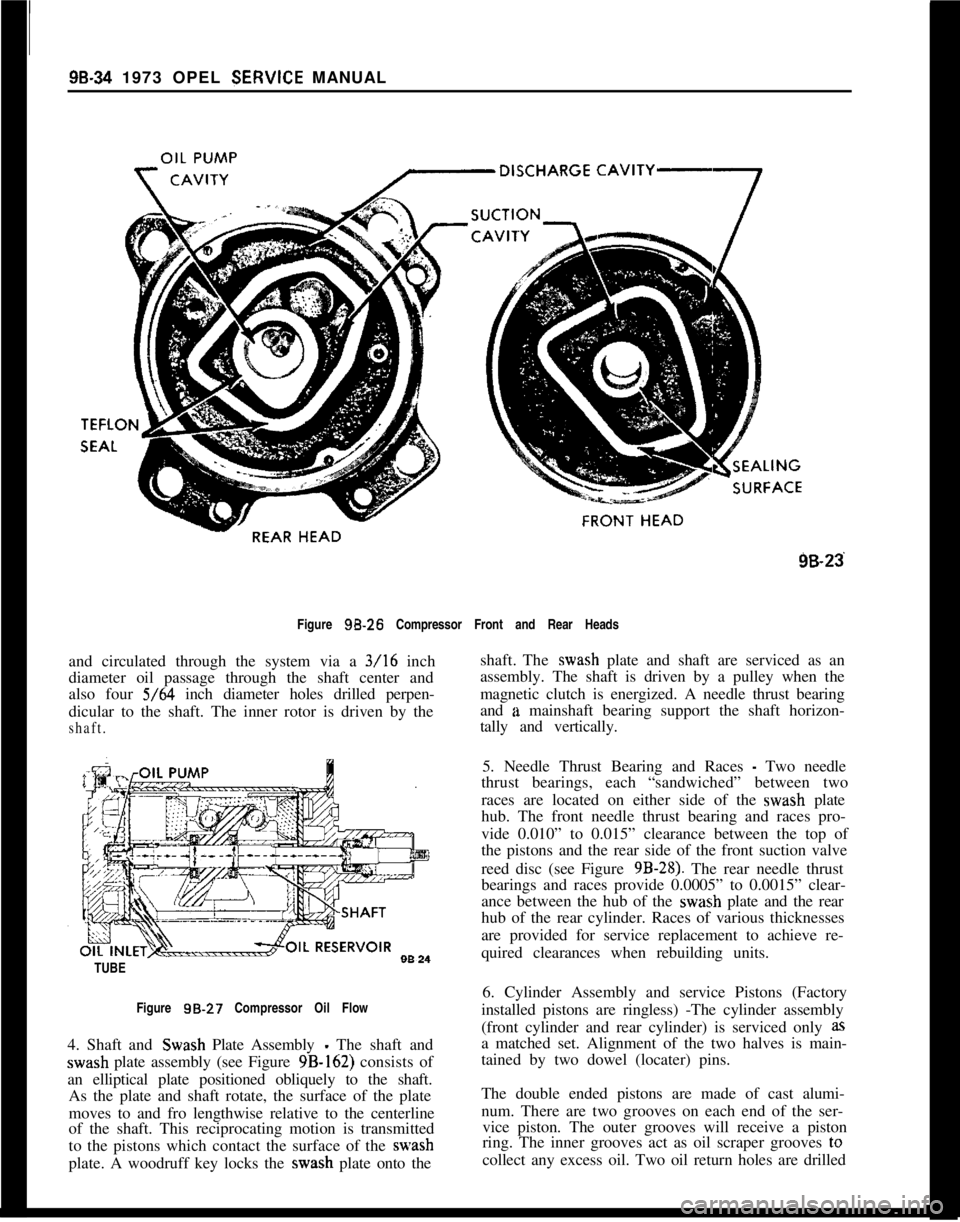
98-34 1973 OPEL 3ERVlCE MANUAL
9B-23Figure
98.26 Compressor Front and Rear Heads
and circulated through the system via a 3/16 inch
diameter oil passage through the shaft center and
also four 5/64 inch diameter holes drilled perpen-
dicular to the shaft. The inner rotor is driven by the
shaft.TUBE
Figure
98-27 Compressor Oil Flow
4. Shaft and
Gash Plate Assembly - The shaft andwash plate assembly (see Figure 9B-162) consists of
an elliptical plate positioned obliquely to the shaft.
As the plate and shaft rotate, the surface of the plate
moves to and fro lengthwise relative to the centerline
of the shaft. This reciprocating motion is transmitted
to the pistons which contact the surface of the wash
plate. A woodruff key locks the wash plate onto theshaft. The wash plate and shaft are serviced as an
assembly. The shaft is driven by a pulley when the
magnetic clutch is energized. A needle thrust bearing
and
L mainshaft bearing support the shaft horizon-
tally and vertically.
5. Needle Thrust Bearing and Races
- Two needle
thrust bearings, each“sandwiched” between two
races are located on either side of the wash plate
hub. The front needle thrust bearing and races pro-
vide 0.010” to 0.015” clearance between the top of
the pistons and the rear side of the front suction valve
reed disc (see Figure
9B-28). The rear needle thrust
bearings and races provide 0.0005” to 0.0015” clear-
ance between the hub of the wash plate and the rear
hub of the rear cylinder. Races of various thicknesses
are provided for service replacement to achieve re-
quired clearances when rebuilding units.
6. Cylinder Assembly and service Pistons (Factory
installed pistons are ringless) -The cylinder assembly
(front cylinder and rear cylinder) is serviced only as
a matched set. Alignment of the two halves is main-
tained by two dowel (locater) pins.
The double ended pistons are made of cast alumi-
num. There are two grooves on each end of the ser-
vice piston. The outer grooves will receive a piston
ring. The inner grooves act as oil scraper grooves to
collect any excess oil. Two oil return holes are drilled
Page 545 of 625
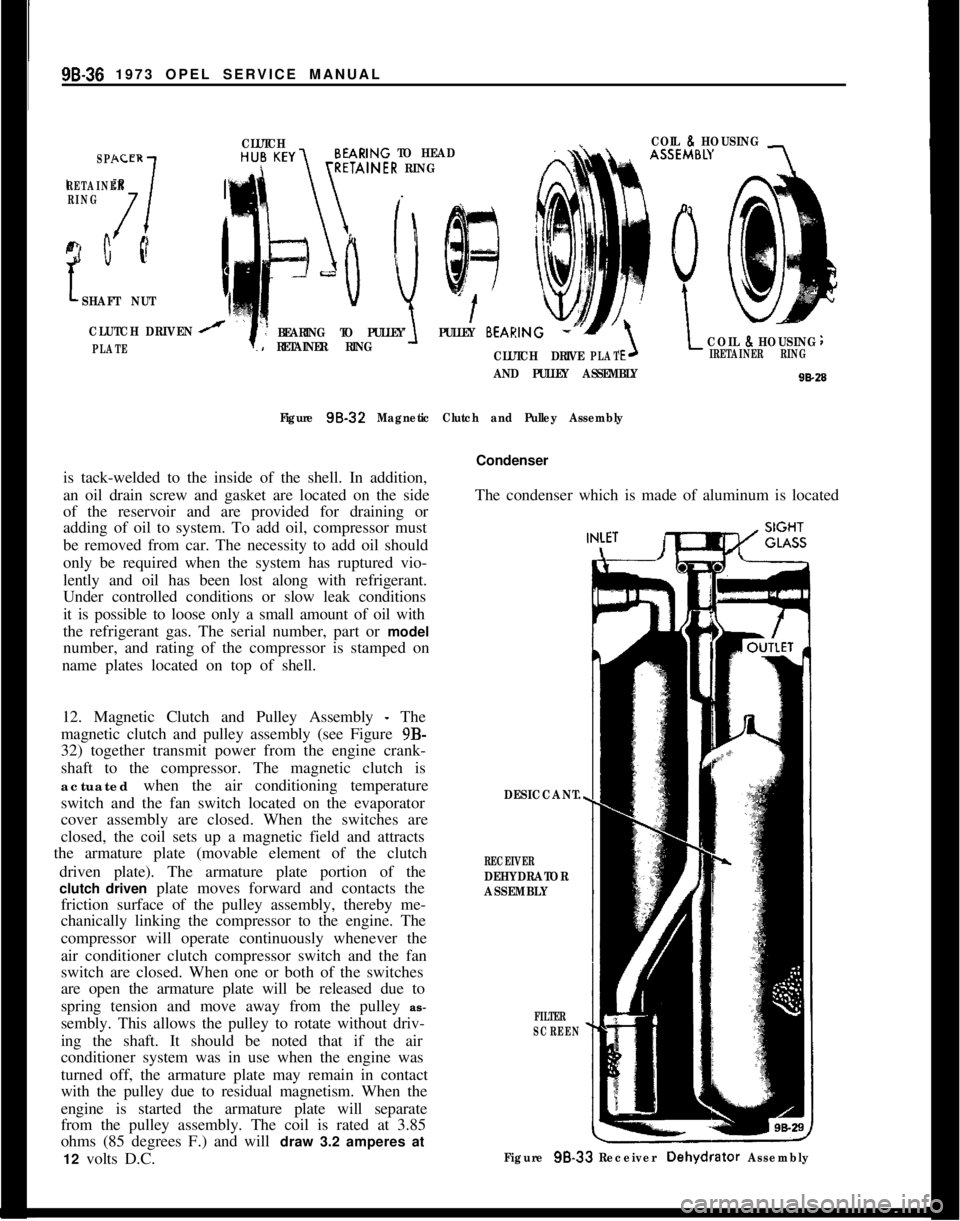
98-36 1973 OPEL SERVICE MANUALSPACER
17
RETAINER
RING
c Q
CLUTCHCOIL 8HOUSINGARING TO HEADTAINER RING
SHAFT NUT
CLUTCH DRIVEN
PLATE
BEARING TO PULLEYPULLEY BEARIN
RETAINER RINGCOIL 8HOUSING
CLUTCH DRIVEPLATIRETAINER RING
AND PULLEY ASSEMBLY
Figure 98-32
Magnetic Clutch and Pulley Assemblyis tack-welded to the inside of the shell. In addition,
an oil drain screw and gasket are located on the side
of the reservoir and are provided for draining or
adding of oil to system. To add oil, compressor must
be removed from car. The necessity to add oil should
only be required when the system has ruptured vio-
lently and oil has been lost along with refrigerant.
Under controlled conditions or slow leak conditions
it is possible to loose only a small amount of oil with
the refrigerant gas. The serial number, part or model
number, and rating of the compressor is stamped on
name plates located on top of shell.
12. Magnetic Clutch and Pulley Assembly
- The
magnetic clutch and pulley assembly (see Figure 9B-
32) together transmit power from the engine crank-
shaft to the compressor. The magnetic clutch is
actuated when the air conditioning temperature
switch and the fan switch located on the evaporator
cover assembly are closed. When the switches are
closed, the coil sets up a magnetic field and attracts
the armature plate (movable element of the clutch
driven plate). The armature plate portion of the
clutch driven plate moves forward and contacts the
friction surface of the pulley assembly, thereby me-
chanically linking the compressor to the engine. The
compressor will operate continuously whenever the
air conditioner clutch compressor switch and the fan
switch are closed. When one or both of the switches
are open the armature plate will be released due to
spring tension and move away from the pulley as-
sembly. This allows the pulley to rotate without driv-
ing the shaft. It should be noted that if the air
conditioner system was in use when the engine was
turned off, the armature plate may remain in contact
with the pulley due to residual magnetism. When the
engine is started the armature plate will separate
from the pulley assembly. The coil is rated at 3.85
ohms (85 degrees F.) and will draw 3.2 amperes at
12 volts D.C.Condenser
The condenser which is made of aluminum is locatedIN:ET
DESICCANT.
RECEIVERDEHYDRATOR
ASSEMBLY
FILTER
SCREEN
Figure 98-33 Receiver Dehydrator Assembly
Page 547 of 625
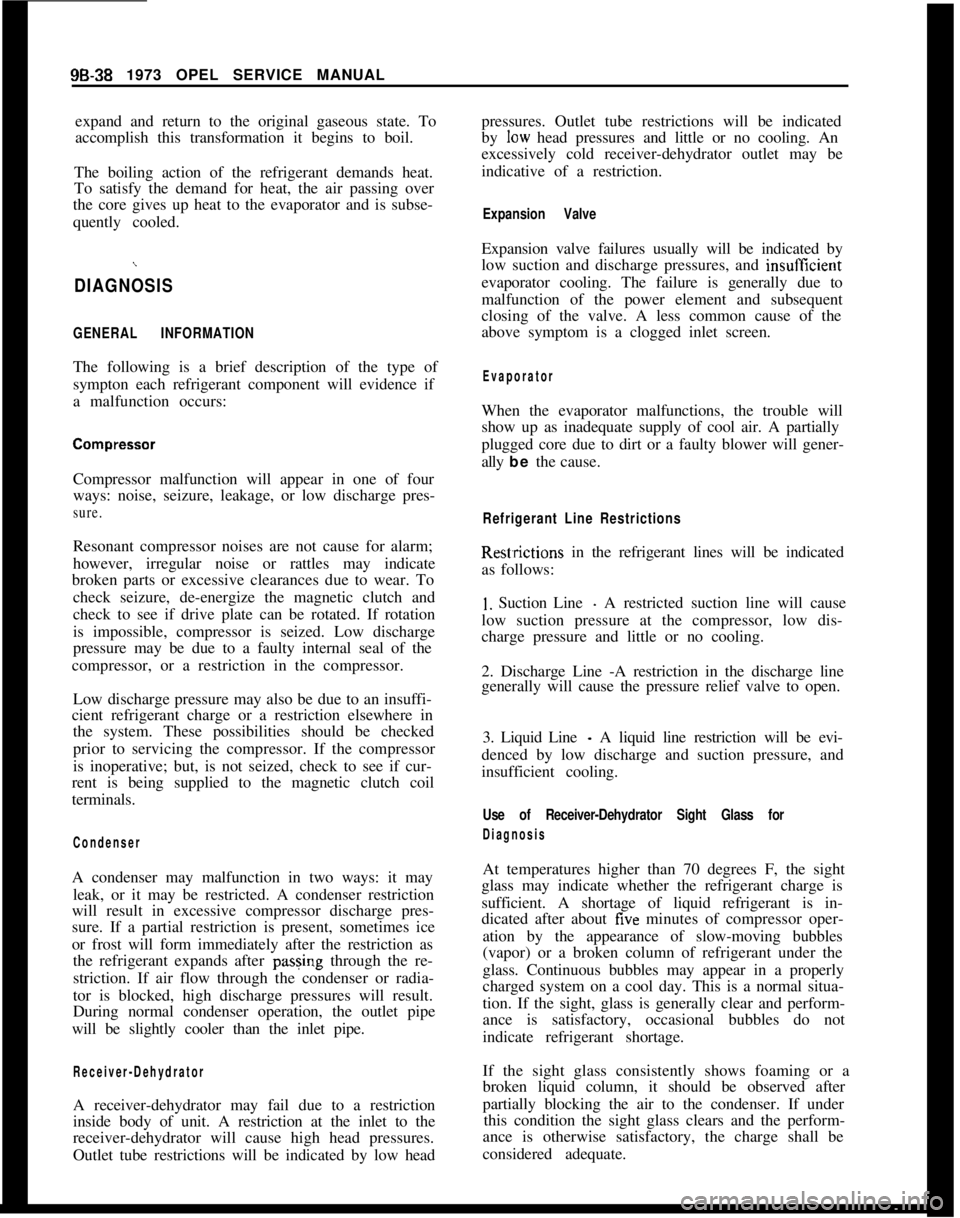
9B-38 1973 OPEL SERVICE MANUAL
expand and return to the original gaseous state. To
accomplish this transformation it begins to boil.
The boiling action of the refrigerant demands heat.
To satisfy the demand for heat, the air passing over
the core gives up heat to the evaporator and is subse-
quently cooled.\
DIAGNOSIS
GENERAL INFORMATIONThe following is a brief description of the type of
sympton each refrigerant component will evidence if
a malfunction occurs:
Compressor malfunction will appear in one of four
ways: noise, seizure, leakage, or low discharge pres-
sure.Resonant compressor noises are not cause for alarm;
however, irregular noise or rattles may indicate
broken parts or excessive clearances due to wear. To
check seizure, de-energize the magnetic clutch and
check to see if drive plate can be rotated. If rotation
is impossible, compressor is seized. Low discharge
pressure may be due to a faulty internal seal of the
compressor, or a restriction in the compressor.
Low discharge pressure may also be due to an insuffi-
cient refrigerant charge or a restriction elsewhere in
the system. These possibilities should be checked
prior to servicing the compressor. If the compressor
is inoperative; but, is not seized, check to see if cur-
rent is being supplied to the magnetic clutch coil
terminals.
CondenserA condenser may malfunction in two ways: it may
leak, or it may be restricted. A condenser restriction
will result in excessive compressor discharge pres-
sure. If a partial restriction is present, sometimes ice
or frost will form immediately after the restriction as
the refrigerant expands after pas?ing through the re-
striction. If air flow through the condenser or radia-
tor is blocked, high discharge pressures will result.
During normal condenser operation, the outlet pipe
will be slightly cooler than the inlet pipe.
Receiver-DehydratorA receiver-dehydrator may fail due to a restriction
inside body of unit. A restriction at the inlet to the
receiver-dehydrator will cause high head pressures.
Outlet tube restrictions will be indicated by low headpressures. Outlet tube restrictions will be indicated
by
low head pressures and little or no cooling. An
excessively cold receiver-dehydrator outlet may be
indicative of a restriction.
Expansion ValveExpansion valve failures usually will be indicated by
low suction and discharge pressures, and insuff%ient
evaporator cooling. The failure is generally due to
malfunction of the power element and subsequent
closing of the valve. A less common cause of the
above symptom is a clogged inlet screen.
EvaporatorWhen the evaporator malfunctions, the trouble will
show up as inadequate supply of cool air. A partially
plugged core due to dirt or a faulty blower will gener-
ally be the cause.
Refrigerant Line Restrictions
Rest~rictions in the refrigerant lines will be indicated
as follows:
I. Suction Line - A restricted suction line will cause
low suction pressure at the compressor, low dis-
charge pressure and little or no cooling.
2. Discharge Line -A restriction in the discharge line
generally will cause the pressure relief valve to open.
3. Liquid Line
- A liquid line restriction will be evi-
denced by low discharge and suction pressure, and
insufficient cooling.
Use of Receiver-Dehydrator Sight Glass for
DiagnosisAt temperatures higher than 70 degrees F, the sight
glass may indicate whether the refrigerant charge is
sufficient. A shortage of liquid refrigerant is in-
dicated after about
five minutes of compressor oper-
ation by the appearance of slow-moving bubbles
(vapor) or a broken column of refrigerant under the
glass. Continuous bubbles may appear in a properly
charged system on a cool day. This is a normal situa-
tion. If the sight, glass is generally clear and perform-
ance is satisfactory, occasional bubbles do not
indicate refrigerant shortage.
If the sight glass consistently shows foaming or a
broken liquid column, it should be observed after
partially blocking the air to the condenser. If under
this condition the sight glass clears and the perform-
ance is otherwise satisfactory, the charge shall be
considered adequate.
Page 549 of 625

98.40 1973 OPEL SERVICE MANUAL
2. Interconnect manifold and gage set (J-5725-01),
gage charging lines (J-5418) and gage adapters
(J-5420) to air conditioning system as shown in Figure
9B-40.3. Place transmission in “Park” for automatics and
in neutral for manuals. Apply hand brake.
4. Turn blower switch to the “Hi” position.
5. Turn temperature switch to “Max” position.
6. Run engine at 2000 RPM for ten (10) minutes with
car doors and windows closed and the hood up. Place
a high volume industrial type fan in front of radiator
if head pressure should exceed 250 psi and also at
high ambients to bring the pressures to within the
limits specified in the Functional Charts in Division
V.In the case of the Opel 1900 and the Manta, a ther-
mometer should be placed in a position to read the
temperature of the air discharging from the right-
hand A/C outlet. In case of the GT, a thermometer
should be placed in a position to read the tempera-
ture of the air discharging from the left-rear A/C
outlet.
HEATER-AIR CONDITIONER REFRIGERANT
CIRCUIT TROUBLE DIAGNOSIS GUIDE
Insufficient Cooling (Check Air Flow)
Normal Air Flow (Inspect system for visual defects.
Run functional tests.)
Discharge Air
- Normal Temp Check for air leaks
through dash, car body, windows, or from heater or
ventilators.
Discharge Air
- High Temp Check sight glass for
foaming and compressor clutch for engagement.
No Compressor Clutch Engagement Check connec-
tions at clutch switch, harness connectors, and check
clutch switch.
No Foaming Compare evaporator pressure to that
on functional test table.
Foaming System is probably low on refrigerant.
Check for leaks, repair, evacuate, and charge. If
foaming still occurs, check for restriction in refriger-
ant lines between condenser and receiver dehydrator.
Evaporator Pressure Normal Compare head pres-
sure to pressure on functional test table.
Evaporator Pressure Low Ice may be forming on
evaporator. Low volume of air discharging at A/C
outlet after system has been running above idle con-dition
,for approximately 15-30 min.utes. Discharging
air gradually elevating in temperature. Check expan-
sion valve. If valve isn’t permitting flow of liquid,
this will be indicated by a warm pipe out of the
evaporator. This may be caused by: 1) Clogged or
Plugged inlet screen in the expansion valve; 2)
Broken capillary line; or 3) Discharged temperature
bulb. If the valve is okay, the pipe out of the evapora-
tor will be cold.
Evaporator Pressure High Check the expansion
valve to determine if themobulb is making good con-
tact and is properly insulated. Operate engine at 2000
RPM with maximum air conditioning setting. If
evaporator pressure remains high, feel suction line.
If line feels frosty or extremely
(cold with relative
high ambient conditions, then partially cover the
condenser to obtain head pressures from 265 psi to
280 psi maximum. If evaporator pressure rises above
30 psi, change the expansion valve.
Also, check if compressor may be the cause due to
some internal or external mechanical trouble which
prevents reduction of pressure. Check for external
troubles, slipping belt, bad clutch and/or pulley, or
improper clutch engagement, before investigating
the compressor internally.
Head Pressure High Check for the following: Con-
denser air flow low, air in system, excessive refriger-
ant in system, restriction in condenser.Head.PressureLowRestriction in flow of refrigerant
to evaporator, or expansion valve plugged or defec-
tive.
Low Air Flow (Check blower operation and
evaporator. Check operation of controls.)
Ice BIocking Evaporator Run functional test. If
evaporator pressure is low, ice may form on evapora-
tor and reduce air flow.
Evaporator Pressure Low Ice may be forming on
evaporator. Low volume of air discharging at A/C
outlet after system has been running above idle con-
dition for approximately 15-30 minutes. Discharging
air gradually elevating in temperature. Check expan-
sion valve. If valve isn’t permitting flow of liquid,
this will be indicated by a warm pipe out of the
evaporator. This may be caused by: 1) Clogged or
plugged inlet screen in the expansion valve; 2)
Broken capillary line, or 3) Discharged temperature
bulb. If the valve is okay, the pipe out of the evapora-
tor will be cold.BlowerNot OperatingCheck for the following: Fuse
blown, blower switch defective, wire broken or loose
connection, poor ground connection, or blower mo-
tor defective.
Page 558 of 625
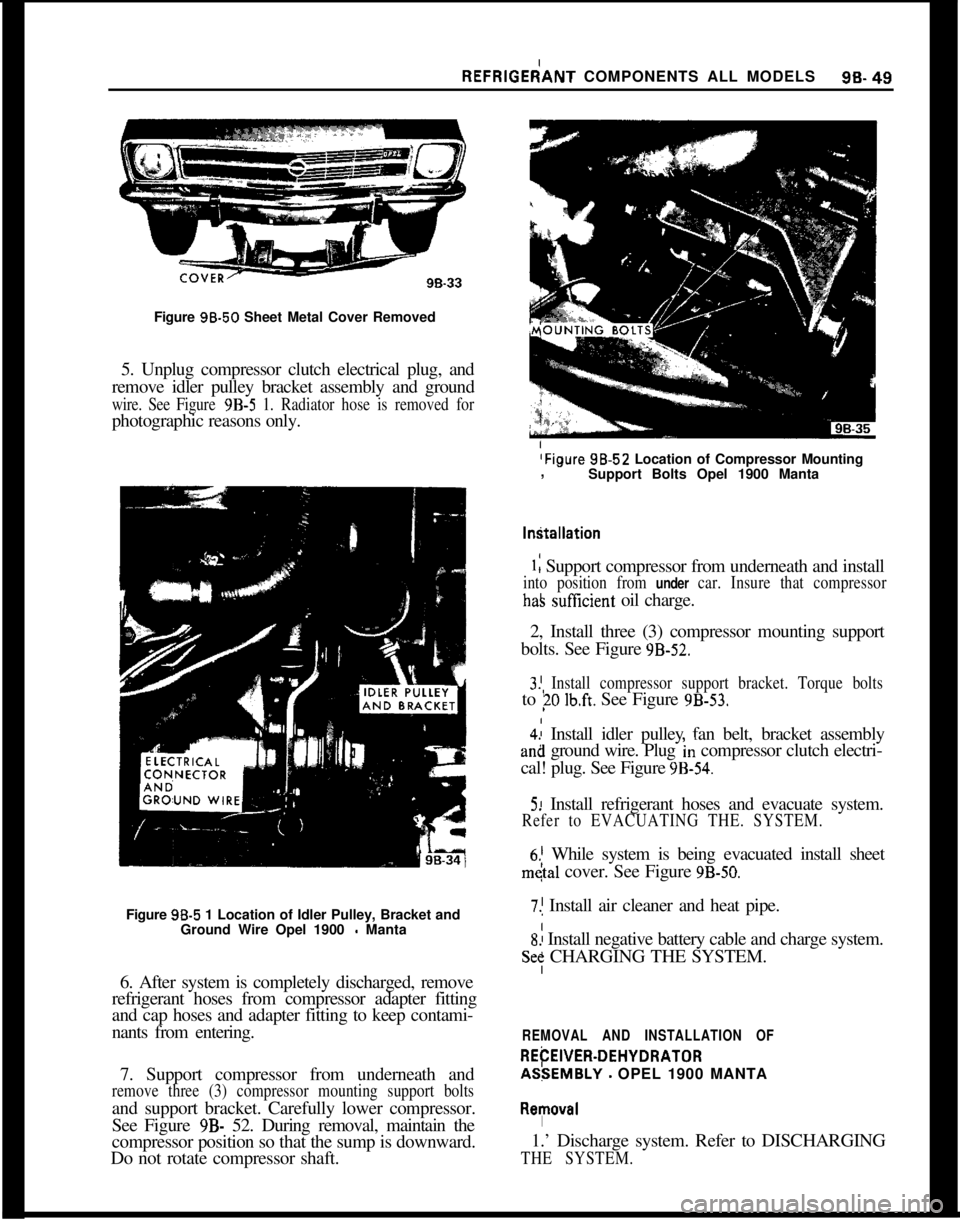
REFRlGEdANT COMPONENTS ALL MODELS96-49Figure 96.50 Sheet Metal Cover Removed
5. Unplug compressor clutch electrical plug, and
remove idler pulley bracket assembly and ground
wire. See Figure 9B-5 1. Radiator hose is removed forphotographic reasons only.
(Figure 98.52 Location of Compressor Mounting
,
Support Bolts Opel 1900 Manta
I
Figure 98-5 1 Location of Idler Pulley, Bracket and
Ground Wire Opel 1900
- Manta
6. After system is completely discharged, remove
refrigerant hoses from compressor adapter fitting
and cap hoses and adapter fitting to keep contami-
nants from entering.
7. Support compressor from underneath and
remove three (3) compressor mounting support boltsand support bracket. Carefully lower compressor.
See Figure
9B- 52. During removal, maintain the
compressor position so that the sump is downward.
Do not rotate compressor shaft.
1: Support compressor from underneath and install
into position from under car. Insure that compressor
haS sutXcient oil charge.
2, Install three (3) compressor mounting support
bolts. See Figure
9B-52.I
3! Install compressor support bracket. Torque boltsto
?O lb.ft. See Figure 9B-53.
4.: Install idler pulley fan belt, bracket assemblyan8 ground wire. Plug
‘In compressor clutch electri-
cal! plug. See Figure
9B-54.
5! Install refrigerant hoses and evacuate system.
Refer to EVACUATING THE. SYSTEM.
6.’ While system is being evacuated install sheet
m&l cover. See Figure 9B-50.
7.1 Install air cleaner and heat pipe.
S! Install negative battery cable and charge system.
Se: CHARGING THE SYSTEM.
REMOVAL AND INSTALLATION OF
REtiEWEFt-DEHYDRATORAS:EMBLY
- OPEL 1900 MANTA
I
R~l!lOV~lI1.’ Discharge system. Refer to DISCHARGING
THE SYSTEM.
Page 567 of 625

98-58 1973 OPEL SERVICE MANUAL
2. Discharge system. Refer to DISCHARGING
SYSTEM.
3. While system is discharging remove air cleaner
and loosen idler pulley and bracket assembly. See
Figure 98-80.
4. Remove bolt holding compressor adapter fitting
into rear head. Disengage from compressor and tape
closed openings in both lines and ports in rear head.
It is important to seal compressor ports to avoid a
loss of refrigeration oil and also to prevent foreign
material and moisture from entering compressor. See
Figure 9B-82.
5. Remove bolt and ground wire, unplug electrical
connector, and remove 2 rear compressor mounting
bolts. See Figure 98-82.
6. Remove 2 front compressor mounting bolts,
clutch drive belt, and lift out compressor. During
removal, maintain the compressor position so that
the sump is downward. Do not’rotate compressor
shaft. See Figure 9B-84.
Installation1. Install compressor into mounting brackets and
secure with 4 mounting bolts. See Figure
9B-84.2. Untape lines and ports, and install compressor
adapter fitting and bolt using new o-rings. See Figure
9B-82.3. Evacuate system. Refer to, EVACUATING
SYSTEM.
4. While system is being evacuated, install drive belt
and tighten idler pulley. See Figure
9B-80.5. Install bolt and ground wire and plug in electrical
connector. See Figure
9B-83.6. Install air cleaner and negative battery cable.
7. Charge system. Refer to, CHARGING SYS-
TEM.
REMOVAL AND INSTALLATION OF
RECEIVER.DEHYDRATOR
ASSEMBLY. GT
Removal1. Discharge system. Refer to DISCHARGING
SYSTEM.
2. Disconnect refrigerant lines to both ends of re-
ceiver-dehydrator and tape closed open ends of
re-
9862Figure 98.85 Refrigeration Hose Clamps Installation
GT
frigerant lines, and also the open
e:nds of the inlet and
outlet pipes of the receiver-dehydrator. See Figure
9B-86.Figure 98.86 Receiver-Dehydrator GT
3. Remove 2 screws securing receiver-dehydrator
and clamps to support bracket and lift out receiver
dehydrator. See Figure
9B-86.
Installation1. Install receiver-dehydrator using new o-rings
during installation. Lubricate o-rings prior to instal-
lation using No. 525 viscosity oil.
.